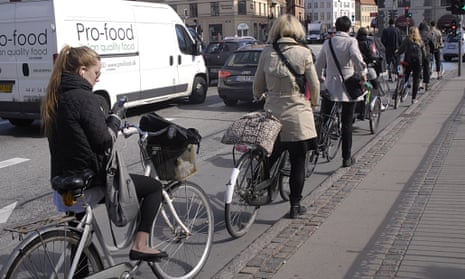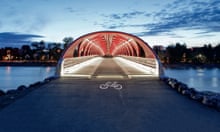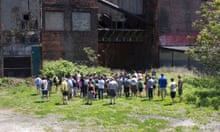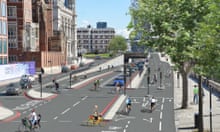Copenhagen remains the benchmark as cities around the world try to figure out how to take the bicycle seriously as a mode of transport again, and enable this 19th-century invention to solve 21st-century urban challenges.
With its narrow medieval city centre streets and broad 20th-century boulevards, Copenhagen continues to inspire planners and politicians from around the world who can squint a bit and see their home city superimposed on retinal images of the Danish capital.
While the tools for establishing a bicycle-friendly city were designed more than a century ago, in Copenhagen people are figuring out new ways to use them to build beautiful things. There is nowhere producing more new ideas to increase bicycle traffic than the Danish capital.
The great green wave
The ‘green wave’ for cyclists was one of the greatest ideas to come out of the brainstorm started by former actor Klaus Bondam when he was elected on to the city council. On most major arteries leading into the city centre, the traffic lights are coordinated to allow continuous flow of traffic, allowing cyclists to flow into the city in the morning rush hour without putting a foot down. The lights reverse in the afternoon to send people home on a simple, tech-based tailwind.
On certain stretches, LED lights embedded in the asphalt help cyclists keep their speed in order to catch the green light at the upcoming intersection and there are simple speed radar signs reminding cyclists to maintain 20km/h in order to surf the wave. Version 2.0 is currently being tested, with sensors able to register a group of citizens riding together and then keeping the light at the intersection they’re approaching green for a little longer.
The details count too
The simple things matter. Footrests and railings have appeared at a number of intersections, allowing cyclists to wait for the light to change without the irritation of having to hop off the saddle or put a foot down. Add to that my own idea – rubbish bins tilted towards cyclists – allowing for NBA-style gamification when they throw out their coffee cups, apple cores, newspapers and empty cigarette packets.
The Give us a Shout app and website allow citizens to map potholes and other urban hurdles which the city dutifully responds to; LED lights also alert turning motorists to cyclists approaching from behind; rumble strips on cycle tracks warn of curbs, and digital countdown timers 100m before an intersection let you know if you should speed up or freewheel to catch the light and maintain your flow.
Efficient cycle infrastructure makes financial sense
Copenhagen takes bicycle infrastructure seriously – the capital region is building 28 bicycle superhighway routes from the suburbs to the city centre – all on separated infrastructure, with not a lick of useless blue paint.
Over the wider Greater Copenhagen area there are more than 1,000 km of separated cycle tracks and a couple of hundred kilometres of bike lanes. Across the nation, bicycle infrastructure has been boiled down over a century so that there are only four types. Simple, efficient, intuitive.
It’s not all one big eco-hippy love-fest, though – it’s simple financial common sense. The cost of 1km of cycle track is paid off in five years by the health benefits of users getting more exercise. Car traffic drops by 10% on these stretches and cycling increases by 20%. The 41% of the population who arrive at work or school by bike contribute a whopping €235m (£185m) a year to the public coffers. Re-allocating space from less cost-efficient transport forms like cars to modern, cost-effective bicycles makes sense.
Good design improves the behaviour of cyclists
If you want to see improved behaviour among cyclists, just build best-practice infrastructure for them – separate bikes from pedestrians and cars and give them their own space in the urban landscape. Copenhagen has the world’s best-behaved cyclists: only 7% bend or break a traffic law and only 1% do something like run a red light or ride on the pavement. Good design improves behaviour.
Zero-to-hero cities like Seville, Paris, Barcelona, Bordeaux and Dublin had few bikes left a decade ago. Now they are modernising and are well on their way to becoming bicycle-friendly once again. Infrastructure – teamed with traffic calming, lower speed limits and effective bike-share systems – led the way.
The perception of safety is crucial
Making cycling safe with separated infrastructure, and prioritising it as a transport form encourages a broad societal group to choose the bicycle. Copenhagen focuses on the perception of safety as much as on actual safety. The citizens should feel safe while cycling, as well as actually being kept safe.
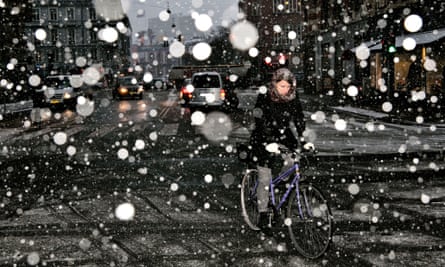
It’s not about the lycra – it’s about all ages and wages
Copenhagen has long understood the concept of ‘citizen cyclists’. The city has built infrastructure for the 99% – not for those riding about in tight-fitting, man-made fibres. It’s not about who is cycling now, it’s about who could be cycling – all ages and wages.
Working recently with the London Borough of Southwark, it was interesting to hear how they saw road-warrior cyclists roaring through the area as a hindrance to their plans for developing a bicycle-friendly corner of the city.
Don’t be afraid to experiment
Copenhagen’s tradition of pilot projects is unique, even though most cities are equally as capable of doing the same. For many years the city has chucked good ideas on to the streets to see if they work and become great ideas. They are, as a rule, well thought out before they are trialled and most of them end up permanent.
It’s a useful and powerful strategy. Sceptical citizens are enlisted as test participants and instead of letting ideas get squashed by public protest and ignorance, citizens can see the good idea actually working. Generally they will understand the intention and the project will stick. If an idea fails, it can easily be removed – but not before a huge amount of data and experience has been gathered, making future good ideas even better.
Sometimes it happens inadvertently. The world’s greatest urban experiment is under way right now in Copenhagen. A new metro ring is being built and 17 stations are under construction at once, making driving difficult. As a result, the modal share for bicycles rose from 36% to 41% between 2012 and 2013, while the number of Copenhagen citizens driving to work fell to 12%. People are like rivers: we will almost always find the quickest route from A to B. If you make that the bicycle, they’ll reward you.
Nobody saw that jump in modal share coming. I hope the city embraces this opportunity and maintains it – otherwise the number will merely fall again in 2019 when the metro is finished.
Don’t block desire lines – use them
For many years Copenhagen has had a deep understanding of the urban anthropology of its cyclists.
Back in the 80s, when separated cycle tracks were being rebuilt after three decades of car-centric planning, people were returning to the bike in great numbers. The city saw them heading down the main car-clogged arteries and decided to try building a high-quality route down a parallel quiet street.
To their surprise, nobody used it. They realised that cyclists merely wished to follow the same ‘desire lines’ as everyone else – choosing the most direct route. The result was a sea-change in modern bicycle planning, with cycle tracks built along the busy streets leading to and from the city centre.
The city realised that you can’t tell people where to go. Rather, they will show you where they want to go and you should listen to them and plan accordingly. City residents are sending subliminal signals about urban design 24 hours a day – and the modern metropolis watches and redesigns accordingly.
Put your money where your mouth is
Building a network of bicycle infrastructure and taking cycling seriously as transport requires investment. Luckily, it’s a fraction of the cost of motorway expansion.
Copenhagen puts its money where its mouth is. What started with the first new link over the harbour in seven centuries – the bicycle and pedestrian bridge Bryggebroen in 2006 – has accelerated rapidly. As well as the cycle superhighways, there are eight new bridges for cyclists and pedestrians either under construction or planned for Copenhagen harbour and its adjacent canals.
The Cykelslangen – or cycle snake – is the newest addition and it is simply beautiful. It fulfils all the requirements of Danish design: functionality, practicality and elegance. The city had earmarked $1m for the bridge but when this design showed up they found the extra $5m needed to make it happen. Copenhagen knows that iconic structures are important – so long as they serve a functional purpose.

Don’t waste time on ridiculous, headline-grabbing schemes
Crazy Bladerunner-style ideas like Lord Foster’s SkyCycle dream prove that cycling for transport is still sadly misunderstood. As Marie Kåstrup from Copenhagen’s Bicycle Office has said, even if Copenhagen had the money to build a version of SkyCycle, they wouldn’t bother. They’re not interested in ‘magpie architecture’ – trying to attract people to big, shiny things that dazzle but that have little functional value.
Cyclists are just fast-moving pedestrians; so all attempts at mating them with cars or other forms of transport will fail. They belong on infrastructure along the streets, cycling to work and to shops, businesses and schools.
Copenhagen continues to work towards becoming even better for cyclists by bringing more of them to streets to contribute valuable life to the urban fabric and to improve mobility for this intelligent transport form.
But … Copenhagen can make mistakes too
Rest assured, Copenhagen can make mistakes, too; sometimes expensive ones. The modern bike-share era started in La Rochelle, France in 1974 but it was the Bycyklen bike-share scheme from Copenhagen in 1995 that inspired 650 cities around the world – and counting – to start the bike-share revolution.
The old bikes were removed last year and replaced with a new Go Bike system – magpie architecture in bicycle form. It’s unusual for Copenhagen to fail so miserably but there are so many things wrong with this idea that it’s painful to describe.
While the average share bike in other cities costs $600-$800, Copenhagen’s new geek-bikes cost $10,000 a piece, including installation and maintenance. They feature a tablet screen to stare at instead of watching the traffic, and they’re not even free, costing $4 for an hour and $5 if you turn on the electric motor – putting fast-moving scooters into the traffic equation along busy cycle tracks where the average speed is 16 km/h.
The goal is that each bike should be used an average of three times a day by local commuters. After the first few months, they are being used 0.8 times a day –primarily by tourists. It’s the most expensive tourist gimmick in the history of modern transport – and taxpayers are footing the bill. Copenhagen should have just copied the Dutch OV Fiets bike-share system at a fraction of the price.
Despite that horrific fail, the example of Copenhagen offers all the tools you need to start immediate construction of a bicycle-friendly city. The best thing is that everything on the list can be purchased for the cost of 6km of Foster’s SkyCycle or the newly proposed, and equally ridiculous, floating cycle track on the Thames.
Mikael Colville-Andersen is chief executive of Copenhagenize Design Company.
